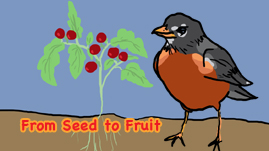Teachers' Domain - Digital Media for the Classroom and Professional Development
User: Preview


KET's Everyday Science is funded in part by Kentucky Power and the American Electric Power Foundation and PNC Bank.
Planting a seed in a cup and watching it grow over time is a wonderful way to introduce the life cycle to young children. Seed to Fruit takes children through the different stages of growth in the life of a cherry tomato plant.
This resource is part of the KET Everyday Science collection.
Children have a natural curiosity about themselves and how they change as they grow. This curiosity offers opportunities for children to observe the stages in life—in themselves and their families, as well as plants, animals, and insects.
In this animated video, children can learn about the life cycle of a cherry tomato plant as they observe the different stages of growth, from a seed to a plant with fruit. This will help them understand aspects of human development, as well as how plants and animals change and develop and what plants require in order to grow.
The Teaching Tips will give you some ideas how to continue the conversation and expand on the content in the interactive.
seed, root, stem, leaf, petal, soil, nutrient, energy, light
seed, plant, cycle, reproduce
 Loading Standards
Loading Standards Teachers' Domain is proud to be a Pathways portal to the National Science Digital Library.
Teachers' Domain is proud to be a Pathways portal to the National Science Digital Library.
